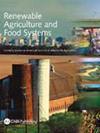Economic trade-offs: analysis of hairy vetch (Vicia villosa) cover crop use in organic tomato (Solanum lycopersicum L.) high tunnel systems across multiple regions
IF 2
3区 农林科学
Q2 AGRICULTURE, MULTIDISCIPLINARY
引用次数: 3
Abstract
Abstract High-tunnel (HT) systems have been shown to effectively improve yields, fruit quality and profitability. In order to maximize returns on investment, HTs are frequently planted successively with both winter and summer cash crops and may include >2 crop cycles per year in some climates. The intense cultivation strategies used in HT systems necessitate increased tillage and nutrient demands posing challenges for soil health, environmental quality and long-term economic sustainability, particularly among organic growers. Seasonal rotations that incorporate fertility-building cover crops, such as legumes and other green manures, have the potential to build soil organic matter, improve crop yield and reduce applications of animal manure and/or compost. The economic impact of cover crop use in HT production systems poses important implications for organic growers. In this study, we present three partial budget analyses to quantify the economic benefits from a leguminous winter cover crop–tomato cash crop rotation in HTs across three regions. Data used in the economic analysis come from multi-year organic HT field trials in Kansas (2016–2019), Kentucky (2016–2019) and Minnesota (2016–2020). Direct financial benefits from hairy vetch (Vicia villosa) cover crop N credits were observed but not sufficient to offset the direct and indirect costs of the cover crop practice. A winter cover crop used in organic HT vegetable systems results in negative financial benefits to producers even with conservation incentive payments. These results highlight challenges for organic growers who are required under the USDA National Organic Program to incorporate soil building practices as part of their rotation schedule. The findings will also be of interest to policy makers as they refine cost-share offerings and programming to incentivize cover crop adoption as a conservation strategy.经济权衡:多个地区有机番茄(Solanum lycopersicum L.)高隧道系统中毛豌豆(Vicia villosa)覆盖作物的使用分析
摘要高通道(HT)系统已被证明可以有效地提高产量、果实质量和盈利能力。为了最大限度地提高投资回报,HTs经常连续种植冬季和夏季经济作物,在某些气候条件下,每年可能包括2个以上的作物周期。HT系统中使用的密集种植策略需要增加耕作和营养需求,这对土壤健康、环境质量和长期经济可持续性,特别是有机种植者提出了挑战。季节性轮作结合了建立肥力的覆盖作物,如豆类和其他绿肥,有可能积累土壤有机质,提高作物产量,并减少动物粪便和/或堆肥的应用。HT生产系统中覆盖作物使用的经济影响对有机种植者产生了重要影响。在这项研究中,我们提出了三个部分预算分析,以量化三个地区HTs中豆科冬季覆盖作物-番茄经济作物轮作的经济效益。经济分析中使用的数据来自堪萨斯州(2016–2019)、肯塔基州(2016-2019)和明尼苏达州(2016至2020)的多年有机HT田间试验。观察到毛豌豆(Vicia villosa)覆盖作物氮信用带来的直接经济效益,但不足以抵消覆盖作物实践的直接和间接成本。有机耐高温蔬菜系统中使用的冬季覆盖作物给生产者带来了负面的经济效益,即使有保护奖励金。这些结果突出了有机种植者面临的挑战,根据美国农业部国家有机计划,他们需要将土壤建设实践纳入轮换计划。这些发现也将引起政策制定者的兴趣,因为他们完善了成本分担方案和计划,以激励将覆盖作物作为一种保护战略。
本文章由计算机程序翻译,如有差异,请以英文原文为准。
求助全文
约1分钟内获得全文
求助全文
来源期刊

Renewable Agriculture and Food Systems
农林科学-农业综合
CiteScore
5.20
自引率
7.40%
发文量
39
审稿时长
>36 weeks
期刊介绍:
Renewable Agriculture and Food Systems (formerly American Journal of Alternative Agriculture) is a multi-disciplinary journal which focuses on the science that underpins economically, environmentally, and socially sustainable approaches to agriculture and food production. The journal publishes original research and review articles on the economic, ecological, and environmental impacts of agriculture; the effective use of renewable resources and biodiversity in agro-ecosystems; and the technological and sociological implications of sustainable food systems. It also contains a discussion forum, which presents lively discussions on new and provocative topics.
 求助内容:
求助内容: 应助结果提醒方式:
应助结果提醒方式:


